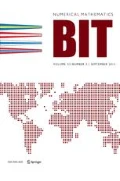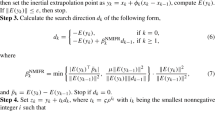Abstract
The eigenvector-dependent nonlinear eigenvalue problem arises in many important applications, such as the discretized Kohn–Sham equation in electronic structure calculations and the trace ratio problem in linear discriminant analysis. In this paper, we perform a perturbation analysis for the eigenvector-dependent nonlinear eigenvalue problem, which gives upper bounds for the distance between the solution to the original nonlinear eigenvalue problem and the solution to the perturbed nonlinear eigenvalue problem. A condition number for the nonlinear eigenvalue problem is introduced, which reveals the factors that affect the sensitivity of the solution. Furthermore, two computable error bounds are given for the nonlinear eigenvalue problem, which can be used to measure the quality of an approximate solution. Numerical results on practical problems, such as the Kohn–Sham equation and the trace ratio optimization, indicate that the proposed upper bounds are sharper than the state-of-the-art bounds.





Similar content being viewed by others
Notes
Note that \(2k\le n\). By the CS decomposition [15, Chapter 1, Theorem 5.1], we know that there exist unitary matrices \({{\,\mathrm{diag}\,}}(U_1,U_2)\) and \({{\,\mathrm{diag}\,}}(U_3,U_4)\) with \(U_1,U_3\in \mathbb {C}^{k\times k}\) and \(U_2,U_4\in \mathbb {C}^{(n-k)\times (n-k)}\), such that \([\widetilde{V}_*, \widetilde{V}_c]=[V_*, V_c] {{\,\mathrm{diag}\,}}(U_1, U_2)\begin{bmatrix}\Gamma&-\Sigma&0\\ \Sigma&\Gamma&0 \\ 0&0&I\end{bmatrix}{{\,\mathrm{diag}\,}}(U_3,U_4)^{\mathrm {H}}\), where \(\Sigma \) and \(\Gamma \) are diagonal matrices and \(\Sigma ^2+\Gamma ^2=I_{k}\). Rewrite \([\widetilde{V}_*, \widetilde{V}_c]=[\widetilde{V}_*, \widetilde{V}_c] {{\,\mathrm{diag}\,}}(U_3U_1^{\mathrm {H}}Q_*\widetilde{Q}_*^{\mathrm {H}}, U_4U_2^{\mathrm {H}}Q_c\widetilde{Q}_c^{\mathrm {H}})\), (2.22) still holds. Then (2.23) follows immediately by setting \(Z=Q_c^{\mathrm {H}}U_2\left[ {\begin{matrix}\Sigma \Gamma ^{-1}\\ 0\end{matrix}}\right] U_1^{\mathrm {H}}Q_*\).
References
Bao, W., Du, Q.: Computing the ground state solution of Bose–Einstein condensates by a normalized gradient flow. SIAM J. Sci. Comput. 25, 1674–1697 (2006)
Cai, Y., Zhang, L.-H., Bai, Z., Li, R.-C.: On an eigenvector-dependent nonlinear eigenvalue problem. SIAM J. Matrix Anal. Appl. 39, 1360–1382 (2018)
Chen, H., Dai, X., Gong, X., He, L., Zhou, A.: Adaptive finite element approximations for Kohn–Sham models. Multiscale Model. Simul. 12, 1828–1869 (2014)
Davis, C., Kahan, W .M.: The rotation of eigenvectors by a perturbation. III. SIAM J. Numer. Anal. 7, 1–46 (1970)
Jarlebring, E., Kvaal, S., Mechiels, W.: An inverse iteration method for eigenvalue problems with eigenvectors nonlinearities. SIAM J. Sci. Comput. 36, A1978–A2001 (2014)
Jia, S.-H., Xie, H.-H., Xie, M.-T., Xu, F.: A full multigrid method for nonlinear eigenvalue problems. Sci. China Math. 59, 2037–2048 (2016)
Khamsi, M.A.: Introduction to metric fixed point theory. In: Almezel, S., Ansari, Q.H., Khamsi, M.A. (eds.) Topics in Fixed Point Theory, pp. 1–32. Springer, Cham (2014)
Lin, W.-W., Sun, J.-G.: Perturbation analysis of the periodic discrete-time algebraic Riccati equation. SIAM J. Matrix Anal. Appl. 24, 411–438 (2002)
Liu, X., Wang, X., Wen, Z., Yuan, Y.: On the convergence of the self-consistent field iteration in Kohn–Sham density functional theory. SIAM J. Matrix Anal. Appl. 35, 546–558 (2014)
Liu, X., Wen, Z., Wang, X., Ulbrich, M., Yuan, Y.: On the analysis of the discretized Kohn–Sham density functional theory. SIAM J. Matrix Anal. Appl. 53, 1758–1785 (2015)
Martin, R.M.: Electronic Structure: Basic Theory and Practical Methods. Cambridge University Press, Cambridge (2004)
Ngo, T., Bellalij, M., Saad, Y.: The trace ratio optimization problem for dimensionality reduction. SIAM J. Matrix Anal. Appl. 31, 2950–2971 (2010)
Rice, J.: A theory of condition. SIAM. J. Numer. Anal. 3, 287–310 (1966)
Saad, Y., Chelikowsky, J.R., Shontz, S.M.: Numerical methods for electronic structure calculations of materials. SIAM Rev. 52, 3–54 (2010)
Stewart, G .W., Sun, J g: Matrix Perturbation Theory. Academic Press, Boston (1990)
Sun, J.-G.: Perturbation theory for algebraic Riccati equations. SIAM J. Matrix Anal. Appl. 19, 39–65 (1998)
Sun, J.-G.: Perturbation analysis of the matrix equation \(X= Q+ A^H\, (\widehat{X}- C)^{-1}\) A. Linear Algebra Appl. 372, 33–51 (2003)
Sun, J.-G., Xu, S.-F.: Perturbation analysis of the maximal solution of the matrix equation \(X+A^{\ast }X^{-1}A=P\). II. Linear Algebra Appl. 362, 211–228 (2003)
Yang, C., Meza, J.C., Wang, L.-W.: A trust region direct constrained minimization algorithm for the Kohn–Sham equation. SIAM J. Sci. Comput. 29, 1854–1875 (2007)
Zhang, L.-H., Li, R.-C.: Maximization of the sum of the trace ratio on the Stiefel manifold, I: theory. Sci. China Math. 57, 2495–2508 (2014)
Zhang, L.-H., Li, R.-C.: Maximization of the sum of the trace ratio on the Stiefel manifold, II: computation. Sci. China Math. 58, 1549–1566 (2015)
Zhang, L.-H., Yang, W.H.: Perturbation analysis for the trace quotient problem. Linear Multilinear Algebra 61, 1629–1640 (2013)
Acknowledgements
We are grateful to the referees for their valuable comments and suggestions. We also would like to thank Prof. Ren-Cang Li from the University of Texas at Arlington for helpful comments on a preliminary draft of this paper.
Author information
Authors and Affiliations
Corresponding author
Additional information
Communicated by Daniel Kressner.
Publisher's Note
Springer Nature remains neutral with regard to jurisdictional claims in published maps and institutional affiliations.
This work was supported by NSFC Nos. 11671023, 11671337, 11771188. The research of Zheng-Jian Bai was partially supported by the Fundamental Research Funds for the Central Universities (No. 20720180008). The research of Zhigang Jia is partially supported by the Priority Academic Program Development Project (PAPD) and the Top-notch Academic Programs Project (No. PPZY2015A013) of Jiangsu Higher Education Institutions, and the Natural Science Foundation of the Jiangsu Higher Educations of China (No.18KJA110001).
Rights and permissions
About this article
Cite this article
Cai, Y., Jia, Z. & Bai, ZJ. Perturbation analysis of an eigenvector-dependent nonlinear eigenvalue problem with applications. Bit Numer Math 60, 1–29 (2020). https://doi.org/10.1007/s10543-019-00765-4
Received:
Accepted:
Published:
Issue Date:
DOI: https://doi.org/10.1007/s10543-019-00765-4




